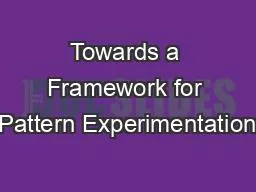

Understanding empirical validity in requirements engineering patterns Travis D Breaux Hanan Hibshi Ashwini Rao Carnegie Mellon University JeanMichel Lehker University of Texas at San Antonio ID: 803743
Download The PPT/PDF document "Towards a Framework for Pattern Experime..." is the property of its rightful owner. Permission is granted to download and print the materials on this web site for personal, non-commercial use only, and to display it on your personal computer provided you do not modify the materials and that you retain all copyright notices contained in the materials. By downloading content from our website, you accept the terms of this agreement.
Slide1
Towards a Framework for Pattern ExperimentationUnderstanding empirical validity in requirements engineering patternsTravis D. Breaux, Hanan Hibshi, Ashwini RaoCarnegie Mellon UniversityJean-Michel LehkerUniversity of Texas at San Antonio
Second International Workshop on Requirements Patterns (RePa’12)
24 September 2012, Chicago, USA
In conjunction with 20
th
IEEE International Requirements Engineering Conference
Slide2Slide3SP 800-53 Catalog of Security Controls15408:2005 Common CriteriaFunctional Requirements603 ASecurity of Personal InformationHIPAA
SECURITY REQUIREMENTS
Slide4PCI - Data Security Standard3.1.1 Implement data retention and disposalpolicy that includes:Limiting data storage Processes for secure deletion of dataSpecific retention requirements…Identifying requirements is difficult
Slide5Pattern Name: Retention and Disposal PatternPattern Activation:Pattern Triggers:Pattern Outcomes:Patterns provide better cues
Slide6Pattern Name: Retention and Disposal PatternPattern Activation: Data is received, stored or processedPattern Triggers:Data is no longer neededDigital access to the media will changePattern
Outcomes
: Retain data; Dispose data
Patterns improve comprehension
Slide7Pattern Name: Retention and Disposal PatternPattern Activation: Data is received, stored or processedPattern Triggers:The data is no longer neededDigital access to the media will changePattern Outcomes: Retain data; Dispose dataMandatory Extension Points:When was the data acquired?
What laws, regulations or business requirements exist to retain the data?
…
Patterns capture variability
Slide80101010011001010000000011000000001000100149162536496481
Sequence of
s
quares of
n
umbers 1 to 9
Not all patterns are equal
Slide9Do you want to empirically know why patterns work?Do you want to trust me that these patterns work?
Slide10What is pattern application?Requirements analyst shouldRecognize goalRecognize cues in problem descriptionApply patternSatisfy output constraints
Slide11What is pattern validity?InputApplyOutput
Probability
of selecting the right pattern
Probability
of correct output
Slide12Requirements Pattern TaxonomyGoalsRepresentationsSources
Slide13How to evaluate goal satisfaction?We identified 5 goals to improve…Requirements acquisitionRequirements qualityComplianceRequirements engineering processRuntime performance
Slide14Sources influence outcomesRequirements knowledge can be highly or lightly structuredStructure affects individual interpretationLightly structured more variation Highly structured less variation
Slide15Source/Representation (Mis)match
Slide16Cognitive Psychology TheoriesHow do humans learn?How do humans interact with abstractions?
Slide17Does cognition affect application?
Slide18What features of input description increase or decrease validity?Segmentation (Vertical)Level of Inclusiveness (Horizontal)Category
A
B
C
D
Basic Level
Figure developed from E.
Rosch
, “Principles of Categorization,”
Cognition and Categorization
, pp.
27-48, 1978.
Slide19What features of input description increase or decrease validity?Segmentation (Vertical)Level of Inclusiveness (Horizontal)Category
A
B
C
D
Basic Level
Figure developed from E.
Rosch
, “Principles of Categorization,”
Cognition and Categorization
, pp. 27-48, 1978.
Slide20What features of input description increase or decrease validity?Segmentation (Vertical)Level of Inclusiveness (Horizontal)Category
A
B
C
D
Basic Level
Figure developed from E.
Rosch
, “Principles of Categorization,”
Cognition and Categorization
, pp. 27-48, 1978.
Slide21Ongoing WorkDiving deeper into cognitive psychologyDesigning experiments for pilot studiesExtending literature review of our requirements pattern taxonomy
Slide22AcknowledgementThis presentation is based on the Pecha Kucha template available athttp://www.conferencesthatwork.com/index.php/presentations/2011/09/tips-for-organizing-pecha-kucha-sessions/Second International Workshop on Requirements Patterns (RePa’12)24 September 2012, Chicago, USAIn conjunction with 20th IEEE International Requirements Engineering Conference